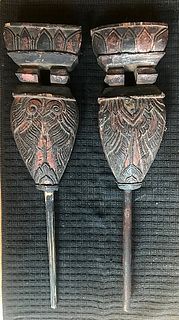Japanese Edo Steel Katana w/ Gilt Menuki
About Seller
686 S Taylor Ave, Ste 106
Louisville, CO 80027
United States
Selling antiquities, ancient and ethnographic art online since 1993, Artemis Gallery specializes in Classical Antiquities (Egyptian, Greek, Roman, Near Eastern), Asian, Pre-Columbian, African / Tribal / Oceanographic art. Our extensive inventory includes pottery, stone, metal, wood, glass and textil...Read more
Two ways to bid:
- Leave a max absentee bid and the platform will bid on your behalf up to your maximum bid during the live auction.
- Bid live during the auction and your bids will be submitted real-time to the auctioneer.
Bid Increments
| Price | Bid Increment |
|---|---|
| $0 | $25 |
| $300 | $50 |
| $1,000 | $100 |
| $2,000 | $250 |
| $5,000 | $500 |
| $10,000 | $1,000 |
| $20,000 | $2,500 |
| $50,000 | $5,000 |
| $100,000 | $10,000 |
| $200,000 | $20,000 |
About Auction
Jun 27, 2024
Classical antiquities, ancient and ethnographic art from cultures encompassing the globe. Artemis Gallery info@artemisgallery.com
- Lot Description
East Asia, Japan, early Edo Period, ca. 1600 to 1610 CE. A stunning steel katana of lengthy, unsigned (o-suriage) form featuring a shinogi-cukuri blade profile and an attractive gunome-choji temper pattern along with a diamond-shaped tip. The handle (tsuka) is lined with stingray skin and accented with gold-colored menuki beneath the forest-green handle wrappings (tsuka-ito). The end caps (fuchi and kashira) are comprised of shakudo while the sukashi-form hand guard (tsuba) is shaped like a series of curved clouds. The lacquer-covered scabbard is fitted with a green tie belt and is likely a more-modern replacement for the original. Size (w/ sheath): 40" L x 3" W x 3.3" H (101.6 cm x 7.6 cm x 8.4 cm); (blade): 29" L x 1.125" W (73.7 cm x 2.9 cm)
The katana is an example of a daito, a long sword, that could only be worn by samurai of higher rank (shorter swords called wakizashi could be worn by craftsmen, traders, and merchants, and are more commonly found today). Over the centuries that katana were made, the process of their manufacture became heavily regulated. For example, in 1683, the Tokugawa Shogunate made laws about the maximum size of katana and wakizashi. Meanwhile, once a samurai took ownership of his new weapon, he had to wear it in a highly regulated manner. Katana in this period were both deadly weapons and signs of status. The craftsmanship of this piece is evident and reflects hundreds of hours of work.
Provenance: private Jones collection, Boulder, Colorado, USA; ex-private Sacramento, California, USA collection
All items legal to buy/sell under U.S. Statute covering cultural patrimony Code 2600, CHAPTER 14, and are guaranteed to be as described or your money back.
A Certificate of Authenticity will accompany all winning bids.
We ship worldwide and handle all shipping in-house for your convenience.
#186055Condition
Blade and handle are from the early Edo period; scabbard, tie belt, and handle end caps are likely more modern replacements for the original components. Minor nicks on blade, otherwise intact and excellent. Great luster across most surfaces.
- Shipping Info
-
All shipping is handled in-house for your convenience. Your invoice from Artemis Gallery will include shipping calculation instructions. If in doubt, please inquire BEFORE bidding for estimated shipping costs for individual items.
-
- Buyer's Premium



 EUR
EUR CAD
CAD AUD
AUD GBP
GBP MXN
MXN HKD
HKD CNY
CNY MYR
MYR SEK
SEK SGD
SGD CHF
CHF THB
THB














